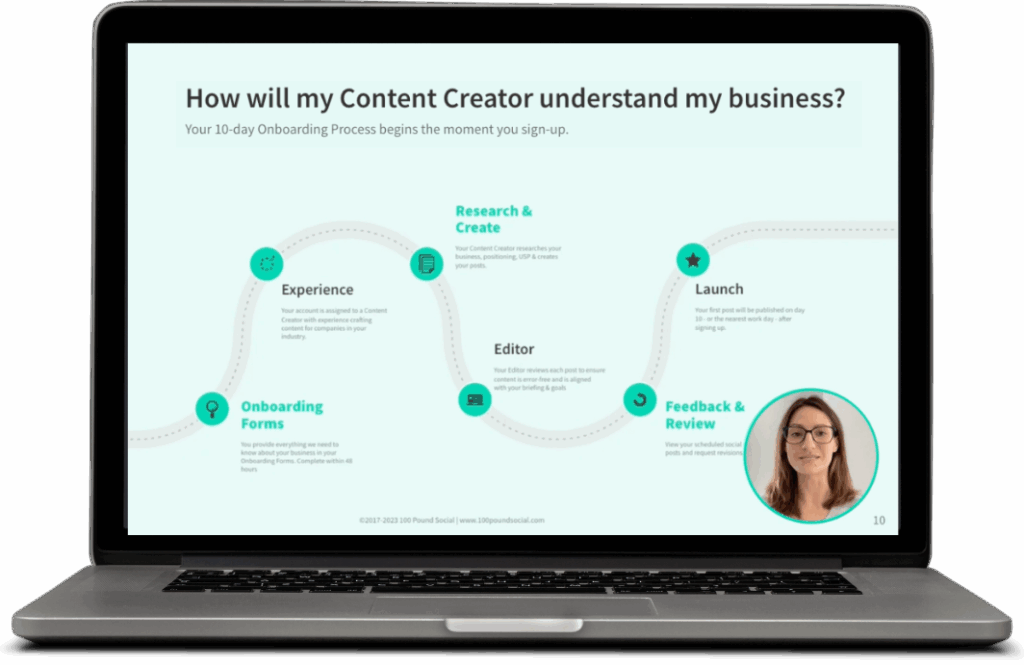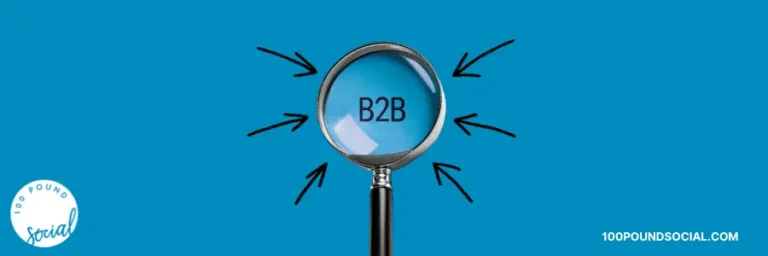Social media metrics and social media KPIs play a big role in today’s B2B marketing.
These metrics help business owners make smart choices in their day-to-day operations.
By focusing on the right metrics, businesses can see which content:
- gets potential clients interested
- which channels bring in quality leads
- and where to direct their efforts for the best outcomes.
The result?
Happy returning customers, more sales and knowing exactly what decisions to make.
Keep reading to see the specific B2B KPIs for social media you should focus on to achieve these results.
Why Social Media KPIs are Important for B2B Success
B2B KPIs for social media differ significantly from B2C metrics in multiple ways.
B2C aims for quick sales and wide reach.
On the other hand, B2B focuses on building relationships and long-term value. Also, the sales process in B2B often takes months rather than minutes. Here, steady engagement matters more than a fast sale.
B2B companies can achieve this by tracking numbers and relationship signs.
Most businesses do track quantitative metrics like website visits and form submissions. However, there are also qualitative measures, such as comment tone and how deep the relationships go. These are crucial when it comes to engagement quality.
Take a B2B software company, for example. They may have fewer engagements than a B2C brand but interact more with decision-makers. Their KPIs for social media should focus on the right metrics, which might include:
- Reach and impressions
- Engagement rate
- Click-through rate
- Conversion rate
- Follower growth
- Cost per lead
- Share of voice
- Customer sentiment.
These are all important when growing a B2B business.
And in this case, a platform like LinkedIn deserves special focus.
Content on LinkedIn often shows real business interest better than other sites.
By linking what happens on social media to business results, teams can show how social efforts help grow revenue and business.
The 8 Key Social Media KPIs for B2B Success
The following B2B KPIs are crucial for ensuring your social media efforts align with business goals.
Reach and Impressions
Reach and impressions track how many people see your B2B social media content. These metrics form the basis for brand awareness measurement across platforms.
Reach represents the number of unique users who view your content. For B2B, focus on reaching the right decision-makers rather than raw numbers. A smaller reach among qualified prospects proves more valuable than broad exposure to unqualified audiences.
Let’s say you post content on LinkedIn about financial services. Your post reaches 500 people – that’s your reach. If 100 of those viewers are financial managers at mid-sized companies (your target audience), this reach is more valuable than reaching 5,000 random viewers.
Let’s consider another example.
A hospitality equipment supplier might notice their product demonstration videos get 3x more views (impressions) than text posts. Their Thursday morning posts consistently reach 40% more procurement managers than posts on other days.
In this case, they should focus more on the date and time their posts reach more people.
Also, content visibility varies by type. A business consultant might see:
- How-to guides: 400 views
- Client success stories: 600 views
- Industry trends analysis: 800 views
- Quick tips: 300 views
This data shows which content types resonate with their target audience of small business owners and helps plan future content.
Engagement Rate
Engagement rate measures how often users interact with your social media content through likes, shares, comments, and other actions.
For B2B, quality engagement from decision-makers matters more than high engagement volumes.
Think about a marketing agency. They post weekly content about getting seen on social media.
A good B2B engagement pattern might look like this:
- A weekly post on “How To Get The Attention Of Your Target Market” reaches 1,000 people. From these people, the post gets:
- 15 likes from Marketing Directors
- 3 shares from CEOs at Fortune 500 companies
- 5 detailed comments with questions about content strategy for different platforms
- 2 direct messages requesting pricing
This gives a 2.5% engagement rate (25 interactions ÷ 1,000 impressions × 100).
This is pretty solid for B2B.
Also, quality matters more than quantity.
Say a software development director found their product demonstration video got only 8 comments, but 6 were from qualified buyers asking technical questions.
In turn, each led to a sales conversation.
The point? Quality engagement matters.
To get started, track which discussions convert to leads. Then do more of what works.
Click-Through Rate (CTR)
Click-through rate (CTR) represents the effectiveness of your social media content in driving traffic to your website or landing pages.
This metric shows the percentage of people who see your content and take action by clicking through to learn more.
The formula is simple but powerful: Total Clicks ÷ Total Impressions × 100 = CTR%
Think of CTR like foot traffic in a physical store – if 100 people walk past your storefront (impressions) and 2 come inside (clicks), you have a 2% CTR.
As store owners want more browsers to become shoppers, social media marketers aim to turn content viewers into website visitors.
For B2B companies, especially small businesses, CTR matters because it:
- Measures content relevance to your audience
- Shows if your calls-to-action connect with viewers
- Indicates whether you’re reaching the right decision-makers
- Helps optimise social media spend
- Tracks the journey from awareness to interest
Let’s look at a small IT services company’s social media strategy. They post weekly tech tips linking to detailed guides on their website.
Example post: “Top 5 Cybersecurity Practices for Small Business”
- Impressions: 2,000 views
- Clicks: 25 visits to the full guide
- CTR: 1.25% (25 ÷ 2,000 × 100)
The higher CTR on the above post (compared to their average post) shows that “Top X list” posts perform best.
The company then improves its CTRs on future posts by having:
- Better call-to-action examples:
- Weak: “Read more”
- Better: “Download your free network security checklist”
- A better timing strategy:
- Original: Random posting
- Improved: Tuesday 10am when their target audience of small business owners is active on social media
- Better link preview optimisation:
- Before: Generic blog thumbnail
- After: Custom preview image showing checklist preview
Tracking CTR is also about tracking which platforms drive quality traffic.
For example, if your LinkedIn posts get 3x more clicks than the same content on other platforms, you should probably focus on LinkedIn more.
Let 100 Pound Social Take Care of Your Social Media and Lead Gen in 10-Mins a Month
Conversion Rate
Conversion rate measures how effectively your social media efforts turn visitors into business results.
The results can include signing up, downloading resources, or requesting information.
For B2B businesses, this metric directly ties social media to revenue potential.
Think of conversion rate like a sales funnel: Visitor → Action → Business Value
Calculate it by: Actions Completed ÷ Total Visitors × 100 = Conversion Rate %
Here’s an example of a small industrial supplier:
- 1,000 social media visitors to the website
- 30 download product catalogue
- 15 request quote
Conversion rates:
- 3% catalogue downloads
- 1.5% quote requests
Conversions matter because they:
- Show content effectiveness
- Measure lead generation success
- Help calculate marketing ROI
- Guide content strategy
- Identify sales opportunities
Let’s consider a before/after example of an optimised landing page to increase its conversion rate.
Original landing page:
- Long contact form comprised of 12 fields
- Generic product info
- No customer testimonials
- 0.5% conversion rate
Improved landing page:
- Short form (4 fields: name, company, email, phone)
- Industry-specific benefits
- Three client success stories
- 2.1% conversion rate
Follower Growth
Follower growth measures the expansion of your social media audience over time. For B2B businesses, this metric focuses on attracting the right professional audience rather than just increasing numbers.
Quality followers mean:
- Decision-makers in your industry
- Potential customers
- Industry influencers
- Professional peers
- Engaged participants
Think of follower growth like building a professional network. If you start with 500 LinkedIn followers and in Month 1 you get +25 followers, that’s a 5% growth.
Say these 25 people are made up of:
- 15 procurement managers
- 5 industry consultants
- 5 general followers
…that’s a very specific audience.
Calculating your monthly growth rate can be done as follows:
Monthly growth rate = (New Followers ÷ Starting Followers) × 100
A good B2B follower growth prioritises:
- Industry relevance
- Decision-making authority
- Engagement potential
- Geographic Alignment
- Budget authority
The question we often get asked is, “Is it all about the numbers?”
It’s not.
Here’s a small business example. A SaaS company gains fewer monthly followers than a consumer brand but attracts more qualified leads.
Why?
Their audience consists mainly of IT managers and small business owners.
This focused approach helps build valuable professional networks rather than just large follower counts.
Let’s say that in this example, the monthly follower growth looks as follows:
Starting: 500 LinkedIn followers and after 3 months of targeted content:
- Month 1: +20 followers (15 from target industries)
- Month 2: +25 followers (18 procurement managers)
- Month 3: +22 followers (16 IT executives)
The growth rate: 4.4% monthly average
The company must look at its quality indicators. Upon doing so, they noticed that 70% of new followers were decision-makers from ideal customer profiles.
Therefore it makes sense to keep going with their strategy which includes:
- Publishing detailed case studies about cost savings and efficiency gains
- Creating long-form technical content that demonstrates deep industry expertise
- Engaging directly in comment sections with thoughtful responses
The result? 80% of new followers became sales-qualified leads
Cost Per Lead (CPL)
CPL measures your return on paid social media advertising by calculating the average cost to acquire one qualified lead.
This metric helps small businesses optimise their ad spend and evaluate marketing efficiency.
Key Metrics:
- Total ad spend
- Lead volume
- Lead quality score
- Platform-specific CPL
- Campaign CPL trends
Say that the average B2B social media CPL can range from £20-£390 with an average of around £50. However, this varies by industry and target audience.
Once you know what your average CPL is, it’s time to track these factors:
- Ad creative performance
- Audience targeting precision
- Landing page conversion rates
- Lead qualification rates
- A/B test results
By tracking these factors, you can understand exactly where your cost per lead is coming from. Once you do, you can make changes without fumbling in the dark.
Also, here’s a small business tip.
Start with a £500 monthly budget, test different messages and audiences, and then scale what works best based on lead quality scores.
Share of Voice (SOV)
Share of Voice measures how much of the social media conversation your brand owns compared to competitors in your market.
For small businesses, SOV helps you understand your local market position and spot growth opportunities.
Think of SOV like measuring your business’s “voice” in a room full of conversations. If there are 100 local discussions about IT services, and your company is mentioned in 20, you have a 20% share of voice.
Let’s look at an example.
Say there are a total of 1000 industry social mentions.
From these:
- Your business: 150 mentions (15% SOV)
- Main competitor A: 400 mentions (40% SOV)
- Main competitor B: 250 mentions (25% SOV)
- Others: 200 mentions (20% SOV)
To track your SOV, monitor 2-3 direct competitors instead of trying to track the entire industry.
But what about growing your SOV?
Here are some ideas:
- Commenting first on relevant industry news
- Sharing original equipment maintenance tips
- Starting weekly expert Q&A sessions
- Responding to customer questions faster than competitors
Regular SOV tracking helps small businesses find content gaps competitors miss and build authority in specific market segments.
Customer Sentiment
Customer sentiment measures how people feel about your brand based on social media comments, messages, and mentions.
For small businesses, tracking sentiment helps identify satisfaction trends and address issues before they grow. It’s like taking your business’s emotional temperature through social media feedback.
Think of sentiment tracking as gathering feedback from three categories:
- Positive: praise, recommendations, success stories
- Neutral: questions, general inquiries, information requests
- Negative: complaints, concerns, dissatisfaction
Here’s a small electronics repair business example:
- Monthly sentiment snapshot:
- 50 social media mentions
- 35 positive comments about the quick service
- 10 technical support questions
- 5 negative comments about pricing
To improve customer sentiment, here’s a practical tracking approach you might want to consider:
- Review all social comments
- Log feedback in a simple spreadsheet
- Group by common topics
- Flag urgent concerns
- Share insights with the team
You might also have a response protocol in terms of answering customers:
- Technical questions: Same day
- Service Enquiries: Within 2 hours
- Complaints: Immediate personal response
- Positive feedback: Thank within 24 hours
Regular sentiment tracking helps small businesses maintain strong relationships and address concerns quickly before they affect their reputation.
How to Monitor and Optimise These KPIs
Several tools help track and improve B2B KPIs for social media. Google Analytics tracks website traffic from social channels and measures conversion paths. LinkedIn Ads Analytics provides professional audience insights and content performance data.
Third-party platforms like HubSpot and Hootsuite offer unified dashboards to monitor the right B2B KPIs. These tools help set baselines, track progress, and identify optimisation opportunities.
Here’s a checklist to consider:
- Establish initial benchmarks specific to your industry and audience size: Research average engagement rates, conversion metrics, and growth patterns for companies similar to yours in size and sector. Gather at least 3-6 months of historical data to set realistic baseline expectations.
- Set measurable goals for each KPI: Translate high-level business objectives into specific, quantifiable targets with clear timelines. For example, aim to increase LinkedIn engagement rate from 2% to 3% within one quarter through improved content targeting.
- Review metrics monthly against your benchmarks: Schedule dedicated time each month to analyse all KPIs against your established baselines. Document any significant deviations and identify potential causes for changes in performance.
- Compare performance to competitor and industry standards: Track 3-5 key competitors’ social media performance. Identify gaps and opportunities based on industry-wide performance data.
- Create regular stakeholder reports showing ROI: Develop standardised monthly or quarterly reports highlighting key metrics, trends, and business impact. Include concrete examples of how social media efforts drive business results through leads, sales, or brand awareness.
- Run A/B tests on content, timing, and targeting: Systematically test different content formats, posting schedules, and audience segments against each other. Run each test for at least 2-3 weeks to gather statistically significant data.
- Analyse underperforming metrics: Deep dive into metrics falling below benchmarks by examining content quality, timing, audience targeting, and external market conditions. Create specific action plans to address identified issues.
- Adjust strategy based on findings: Implement changes based on test results and performance analysis. Make one major strategic adjustment at a time to accurately measure impact.
- Repeat the cycle monthly: Maintain a consistent schedule of monthly reviews and quarterly deep dives to ensure continuous improvement. Document learnings and successful strategies for future reference.
Summary
Social media is important for B2B (business-to-business) companies but works differently from B2C (business-to-consumer) marketing.
While B2C focuses on quick sales, B2B is all about building long-term relationships.
These B2B KPIs can help build these long-term relationships:
- Reach and Impressions: How many people see your content, especially focusing on reaching decision-makers rather than just getting large numbers.
- Engagement Rate: How people interact with your posts through likes, comments, and shares. Quality engagement from potential customers matters more than quantity.
- Click-Through Rate (CTR): The percentage of viewers who click your links to visit your website or landing pages.
- Conversion Rate: How many visitors take desired actions, like signing up or requesting information.
- Follower Growth: How your audience grows over time, focusing on attracting the right professional followers rather than just increasing numbers.
- Cost Per Lead (CPL): How much money you spend to get each potential customer through paid social media advertising.
- Share of Voice (SOV): How much of the industry conversation your brand owns compared to competitors.
- Customer Sentiment: How people feel about your brand based on their social media comments and mentions.
Remember that each metric serves a specific purpose in understanding and enhancing social media effectiveness. By tracking and optimising these KPIs for social media, businesses can demonstrate ROI and enhance their strategy. Understanding social media KPIs is key to long-term success in B2B marketing.
Next Steps
Ready to turn these KPIs into real business growth? The expert UK team at 100 Pound Social has helped over 1,000 B2B companies optimise their social media performance and lead generation since 2017.
Our £100 Posts Plan delivers three strategic social media posts weekly across your platforms (LinkedIn, Facebook, X, Google Business Profile, Instagram), backed by a 20-day money-back guarantee.
If you’re ready to transform your B2B social media performance, you can:
- Join our interactive 15-minute demo to see how we’ll elevate your social media strategy
- Get expert content creation tailored to your industry
- Start measuring real ROI from your social media investment
Book a call now to discuss your social media goals with our specialists.







